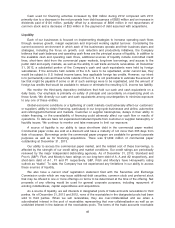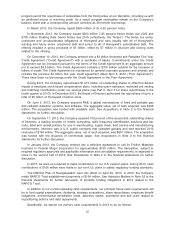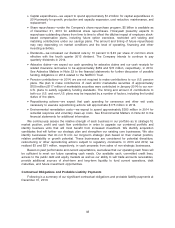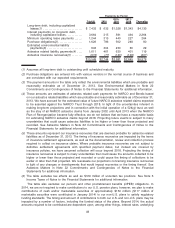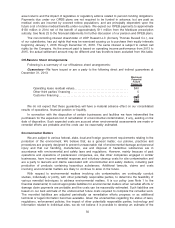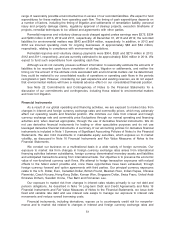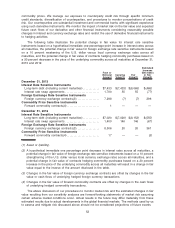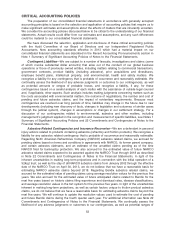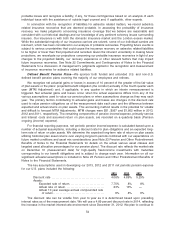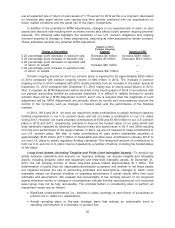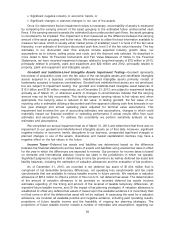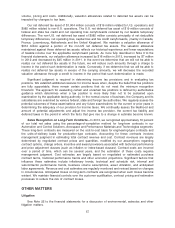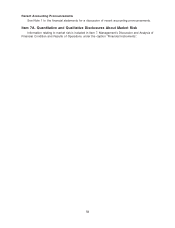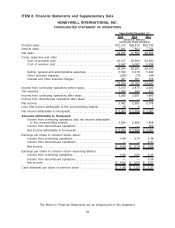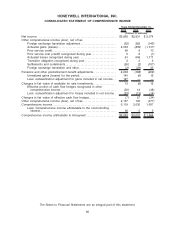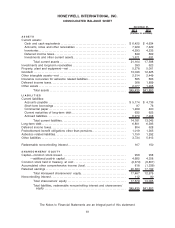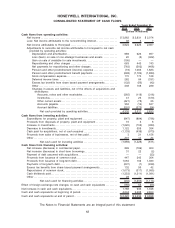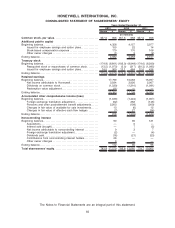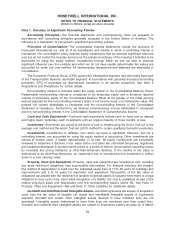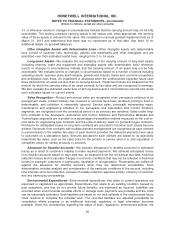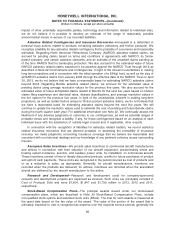Honeywell 2013 Annual Report Download - page 68
Download and view the complete annual report
Please find page 68 of the 2013 Honeywell annual report below. You can navigate through the pages in the report by either clicking on the pages listed below, or by using the keyword search tool below to find specific information within the annual report.•Significant negative industry or economic trends; or
•Significant changes or planned changes in our use of the assets.
Once it is determined that an impairment review is necessary, recoverability of assets is measured
by comparing the carrying amount of the asset grouping to the estimated future undiscounted cash
flows. If the carrying amount exceeds the estimated future undiscounted cash flows, the asset grouping
is considered to be impaired. The impairment is then measured as the difference between the carrying
amount of the asset grouping and its fair value. We endeavor to utilize the best information available to
measure fair value, which is usually either market prices (if available), level 1 or level 2 of the fair value
hierarchy, or an estimate of the future discounted cash flow, level 3 of the fair value hierarchy. The key
estimates in our discounted cash flow analysis include expected industry growth rates, our
assumptions as to volume, selling prices and costs, and the discount rate selected. As described in
more detail in Note 16 Financial Instruments and Fair Value Measures of Notes to the Financial
Statements, we have recorded impairment charges related to long-lived assets of $72 million in 2013,
principally related to property, plant and equipment and $22 million and 2012, principally related to
property, plant and equipment and intangible assets.
Goodwill and Indefinite-Lived Intangible Assets Impairment Testing—Goodwill represents
the excess of acquisition costs over the fair value of the net tangible assets and identifiable intangible
assets acquired in a business combination. Indefinite-lived intangible assets primarily consist of
trademarks acquired in business combinations. Goodwill and indefinite-lived assets are not amortized,
but are subject to impairment testing. Our goodwill and indefinite-lived intangible asset balances of
$13.0 billion and $725 million, respectively, as of December 31, 2013, are subject to impairment testing
annually as of March 31, or whenever events or changes in circumstances indicate that the carrying
amount may not be fully recoverable. This testing compares carrying values to fair values and, when
appropriate, the carrying value is reduced to fair value. In testing goodwill, the fair value of our
reporting units is estimated utilizing a discounted cash flow approach utilizing cash flow forecasts in our
five year strategic and annual operating plans adjusted for terminal value assumptions. This
impairment test involves the use of accounting estimates and assumptions, changes in which could
materially impact our financial condition or operating performance if actual results differ from such
estimates and assumptions. To address this uncertainty we perform sensitivity analysis on key
estimates and assumptions.
We completed our annual impairment test as of March 31, 2013 and determined that there was no
impairment to our goodwill and indefinite-lived intangible assets as of that date. However, significant
negative industry or economic trends, disruptions to our business, unexpected significant changes or
planned changes in use of the assets, divestitures and market capitalization declines may have a
negative effect on the fair values in the future.
Income Taxes—Deferred tax assets and liabilities are determined based on the difference
between the financial statements and tax basis of assets and liabilities using enacted tax rates in effect
for the year in which the differences are expected to reverse. Our provision for income taxes is based
on domestic and international statutory income tax rates in the jurisdictions in which we operate.
Significant judgment is required in determining income tax provisions as well as deferred tax asset and
liability balances, including the estimation of valuation allowances and the evaluation of tax positions.
As of December 31, 2013, we recorded a net deferred tax asset of $1,004 million that is
comprised of net deductible temporary differences, net operating loss carryforwards and tax credit
carryforwards that are available to reduce taxable income in future periods. We maintain a valuation
allowance of $614 million to offset a portion of this non-U.S. net deferred tax asset. The determination
of the amount of valuation allowance to be provided on recorded deferred tax assets involves
estimates regarding (1) the timing and amount of the reversal of taxable temporary differences, (2)
expected future taxable income, and (3) the impact of tax planning strategies. A valuation allowance is
established to offset any deferred tax assets if, based upon the available evidence it is more likely than
not that some or all of the deferred tax asset will not be realized. In assessing the need for a valuation
allowance, we consider all available positive and negative evidence, including past operating results,
projections of future taxable income and the feasibility of ongoing tax planning strategies. The
projections of future taxable income include a number of estimates and assumptions regarding our
56


